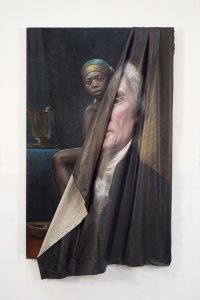
I was intrigued by the topic of our first day’s presentations, largely due to a few instances that stand out from my experiences abroad in relation the role of the art in sharing and celebrating cultures. I have seen it used as a powerful medium to speak to the identity of a historically undervalued population, and serve as a means of truth telling. The example that most frequently comes to mind is the street art in Otavalo, Ecuador, a small city north of Quito where I’ve lived, worked, and returned to multiple times. In this city, few of the walls are blank, and much of the striking graffiti is done by a young indigenous artist named Tenaz. He uses his skills to share messages that celebrate indigenous identity and resilience. The presence of his work has resulted in the streets of Otavalo radiating the pride of local populations, a poignant protest in the face of centuries of marginalization.

The unique graffiti by Tenaz in Otavalo changes the atmosphere of the city
Through our session entitled Media and Arts for Peace: Creativity, Strategy, Storytelling, I gained a much broader perspective about how media and the arts are strategically used (and should be increasingly used) throughout the world to create new understandings and attitudes in society, a crucial aspect of conflict reconciliation. We discussed how arts and media are instrumental in incorporating perspectives and attitudes that help to address and prevent violence. This reality may be reflected in the fact that arts and culture are often the first targets by oppressors, which demonstrates the danger that oppressive regimes see in the arts’ ability to win hearts and minds. We heard from our presenter that 70% of human decisions are based on emotions, pointing to the power of the arts to harness this potential in productive ways, to build empathy and break down misconceptions. Although humans sometimes envision ourselves as deeply analytical, this fact about our decision making is a reminder of how the right message can evoke emotions that are essential in building more peaceful societies.

An example of Titus Kaphar’s work
We learned about numerous inspiring examples of how artists and designers are using their mediums to foster intercultural dialogue for the promotion of peace across the globe, often times opening up discussion that society and governments avoid or struggle to partake in. One particular example that stood out to me is a US based artist named Titus Kaphar, who seeks to stimulate conversation to create more complete narratives about race and our nation’s history. He has a totally unique style, through disrupting Classical and Renaissance pieces by highlighting different faces and stories. As I mentioned in my first blog, before coming to MIIS I was a history teacher. I believe this role offers a unique opportunity to seek out the stories that are not commonly told in textbooks and the mainstream education system, which contributed to my reaction to this artists’ message. I was struck by how his work incites the viewer think about how we have distorted the history of racial minorities and overlooked their perspectives. In Titus’ Ted talk, he begins by working to transform an alarmingly racially biased piece of a wealthy white family with a slave boy and states, “This was in a museum.”

It begs the question, why do we celebrate and promote the history of such a small privileged class, while hoping that the stories of those that are deemed second class citizens quietly disappear? His work serves as a powerful reminder that in order to reconcile conflicts, there is a need to address the truth, and not strategically erase history. Today we saw how art can be more suited to stirring productive emotions to engage in that process than words.

